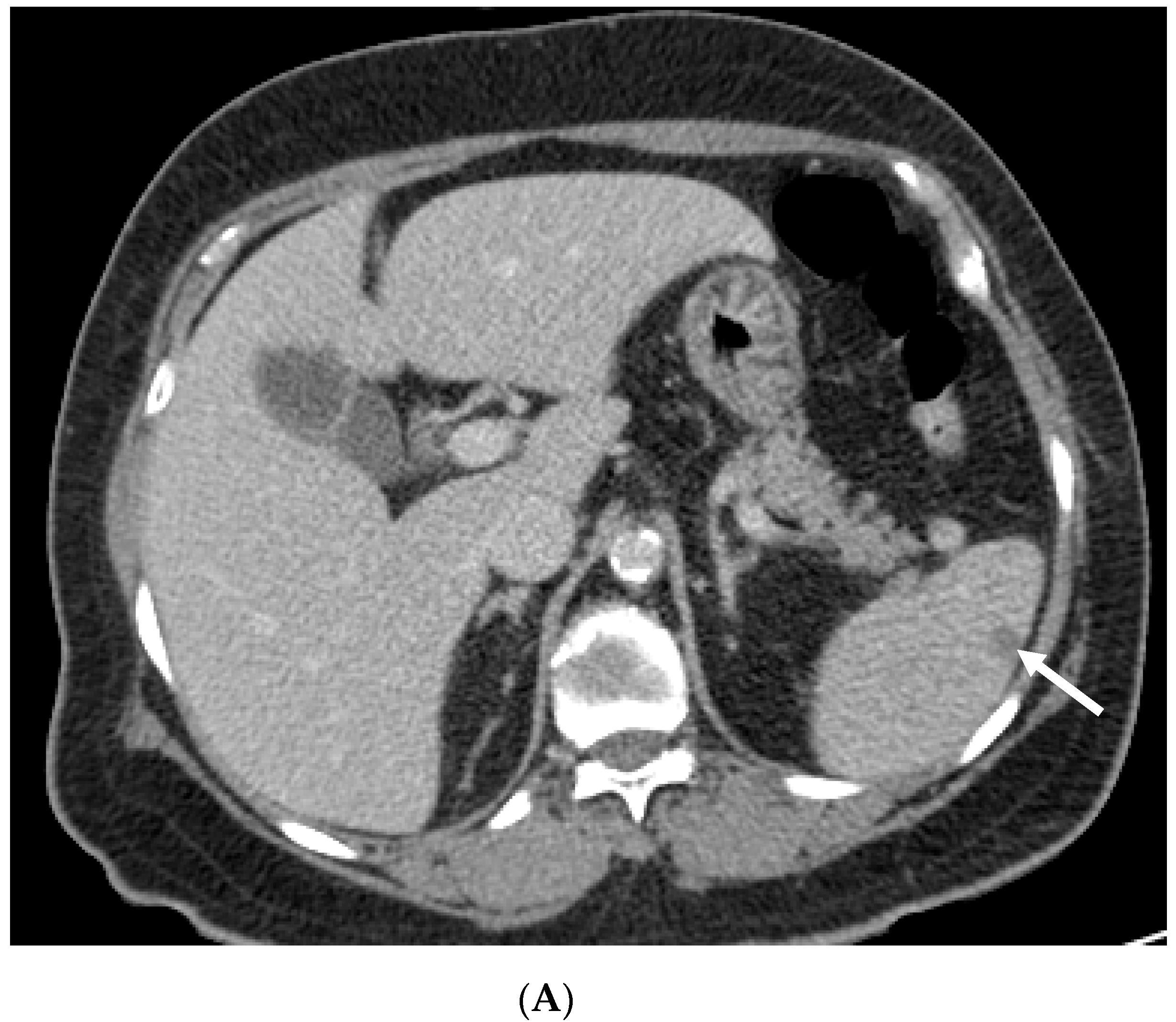Microscopic Polyangiitis Presenting with Splenic Infarction: A Case Report
Abstract
:1. Introduction
2. Case Presentation
3. Discussion
4. Conclusions
Funding
Institutional Review Board Statement
Informed Consent Statement
Conflicts of Interest
References
- Durand-Gasselin, B.; Cevallos, R.; Gayraud, M.; Callard, P.; Amouroux, J.; Casassus, P.; Jarrousse, B. Microscopic polyangiitis: Clinical and laboratory findings in eighty-five patients. Arthritis Rheum. 1999, 43, 421–430. [Google Scholar]
- Gercik, O.; Karasu, S.; Solmaz, D.; Soypacaci, Z.; Cakalagaoglu, F.; Akar, S. Splenic infarction is not rare in granulomatosis with polyangiitis. Clin. Rheumatol. 2020, 39, 1929–1934. [Google Scholar] [CrossRef]
- Jennette, J.C.; Falk, R.J.; Bacon, P.A.; Basu, N.; Cid, M.C.; Ferrario, F.; Flores-Suarez, L.F.; Gross, W.L.; Guillevin, L.; Hagen, E.C.; et al. 2012 revised International Chapel Hill Consensus Conference Nomenclature of Vasculitides. Arthritis Rheum. 2013, 65, 1–11. [Google Scholar] [CrossRef] [PubMed]
- Watts, R.; Lane, S.; Hanslik, T.; Hauser, T.; Hellmich, B.; Koldingsnes, W.; Mahr, A.; Segelmark, M.; Cohen-Tervaert, J.W.; Scott, D. Development and validation of a consensus methodology for the classification of the ANCA-associated vasculitides and polyarteritis nodosa for epidemiological studies. Ann. Rheum. Dis. 2007, 66, 222–227. [Google Scholar] [CrossRef] [PubMed]
- Villiger, P.M.; Guillevin, L. Microscopic polyangiitis: Clinical presentation. Autoimmun. Rev. 2010, 9, 812–819. [Google Scholar] [CrossRef] [PubMed]
- Terrier, B.; Charles, P.; Aumaître, O.; Belot, A.; Bonnotte, B.; Crabol, Y.; Durel, C.-A.; Ebbo, M.; Jourde-Chiche, N.; Lega, J.-C.; et al. ANCA-associated vasculitides: Recommendations of the French Vasculitis Study Group on the use of immunosuppressants and biotherapies for remission induction and maintenance. Presse Med. 2020, 49, 104031. [Google Scholar] [CrossRef] [PubMed]


Publisher’s Note: MDPI stays neutral with regard to jurisdictional claims in published maps and institutional affiliations. |
© 2021 by the author. Licensee MDPI, Basel, Switzerland. This article is an open access article distributed under the terms and conditions of the Creative Commons Attribution (CC BY) license (http://creativecommons.org/licenses/by/4.0/).
Share and Cite
Chung, S.W. Microscopic Polyangiitis Presenting with Splenic Infarction: A Case Report. Medicina 2021, 57, 157. https://doi.org/10.3390/medicina57020157
Chung SW. Microscopic Polyangiitis Presenting with Splenic Infarction: A Case Report. Medicina. 2021; 57(2):157. https://doi.org/10.3390/medicina57020157
Chicago/Turabian StyleChung, Sang Wan. 2021. "Microscopic Polyangiitis Presenting with Splenic Infarction: A Case Report" Medicina 57, no. 2: 157. https://doi.org/10.3390/medicina57020157





